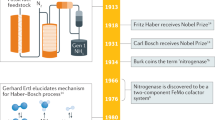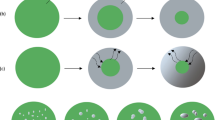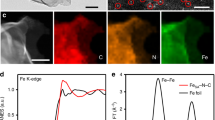Abstract
A low activation energy pathway for the catalytic reduction of nitrogen oxides to N2, with reductants other than ammonia, consists of two sets of reaction steps. In the first set, part of the NO x is reduced to NH3; in the second set ammonium nitrite, NH4NO2 is formed from this NH3 and NO + NO2. The NH4NO2 thus formed decomposes at ~100 °C to N2 + H2O, even on an inert support, whereas ammonium nitrate, NH4NO3, which is also formed from NH3 and NO2 + O2, (or HNO3), decomposes only at 312 °C yielding mainly N2O. Upon applying Redhead's equations for a first order desorption to the decomposition of ammonium nitrite, an activation energiy of 22.4 is calculated which is consistent with literature data. For the reaction path via ammonium nitrite a consumption ratio of 1/1 for NO and NO2 is predicted and confirmed experimentally by injecting NO into a mixture of NH3 + NO2 flowing over a BaNa/Y catalyst. This leads to a yield increase of one N2 molecule per added molecule of NO. Little N2 is produced from NH3 + NO in the absence of NO2.
Similar content being viewed by others
References
E. Millon, Ann. Chim. Phys. 19 (1847) 255.
B. P. Corenwinder, Ann. Chim. Phys. 26 (1849) 296.
A. Kato, S. Matsuda, T. Kamo, F. Nakajima, H. Kuroda and T. Narita, J. Phys. Chem. 85 (1981) 4099.
G. Tu ¨nter, W. Leeuwen and L. Snepvangers, Ind. Eng. Chem. Prod. Res. Dev. 25 (1986) 633.
M. Koebel, M. Elsener and G. Madia, Ind. Chem. Eng. Res. 40 (2001) 52.
Q. Sun, Z. X. Gao, H. Y. Chen and W. M. H. Sachtler, J. Catal. 201 (2001) 89.
F. Poignant, J. L. Freysz, M. Daturi, J. Saussey and J. C. Lavalley, 12th Int. Congr. Catal. Stud. Surf. Sci. Catal. 130B (2000) 1487.
H.-Y. Chen, T. Voskoboinikov and W. M. H. Sachtler, J. Catl. 180 (1998) 171 and 186 (1999) 91.
W. Bin, Y.-H. Yeom, E. Weitz and W. M. H. Sachtler, Appl. Catal. B 48 (2004) 125.
Y.-H. Yeom, B. Wen, W. M. H. Sachtler and E. Weitz, J. Phys. Chem. B 108 (2004) 5386.
A. G. Panov, R. G. Tomkym, M. L. Balmer, C. H. F. Peden, A. Malkin and J. W. Hoard, Soc. Autom. Eng. SAE(2001) 01–3513.
P. A. Redhead, Vacuum 12 (1962) 203.
N. Kolarow and B. Popjankow, Sp. Angelow, Monatshefte fu ¨r Chemie 96 (1962) 949.
R. Q. Long, R. T. Yang and R. Chang, Chem. Commun. 5 (2002) 452.
G. Madia, M. Koebel, M. Elsener and A. Wokaun, Ind. Eng. Chem. Res. 41 (2002) 4008.
Author information
Authors and Affiliations
Rights and permissions
About this article
Cite this article
Li, M., Henao, J., Yeom, Y. et al. Low Activation Energy Pathway for the Catalyzed Reduction of Nitrogen Oxides to N2 by Ammonia. Catalysis Letters 98, 5–9 (2004). https://doi.org/10.1007/s10562-004-6441-y
Issue Date:
DOI: https://doi.org/10.1007/s10562-004-6441-y




